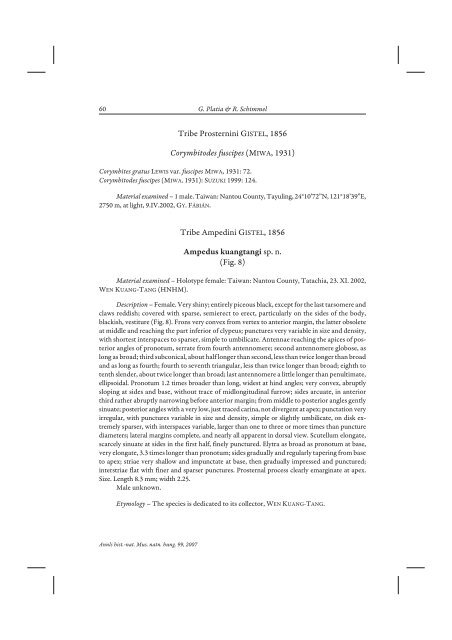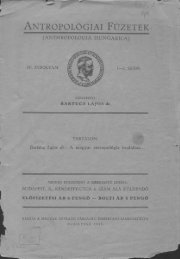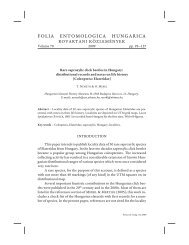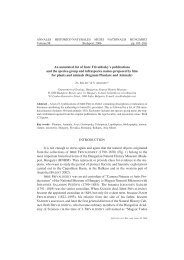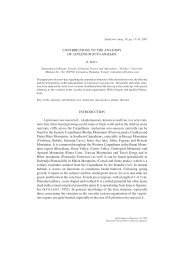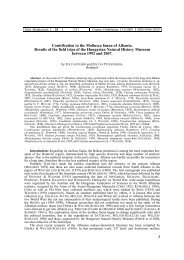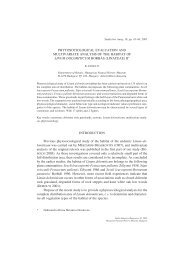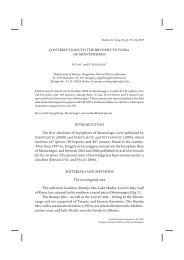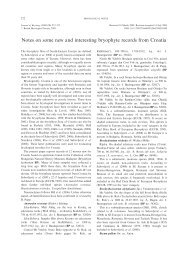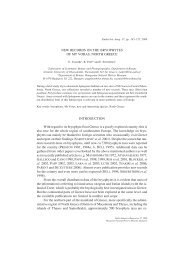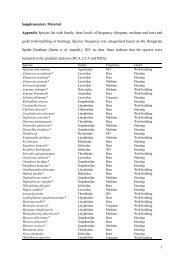60 G. Platia & R. SchimmelTribe Prostern<strong>in</strong>i GISTEL, 1856Corymbitodes fuscipes (MIWA, 1931)Corymbites gratus LEWIS var. fuscipes MIWA, 1931: 72.Corymbitodes fuscipes (MIWA, 1931): SUZUKI 1999: 124.Material exam<strong>in</strong>ed – 1 male. Taiwan: Nantou County, Tayul<strong>in</strong>g, 24°10’72”N, 121°18’39”E,2750 m, at light, 9.IV.2002, GY.FÁBIÁN.Tribe Amped<strong>in</strong>i GISTEL, 1856Ampedus kuangtangi sp. n.(Fig. 8)Material exam<strong>in</strong>ed – Holotype female: Taiwan: Nantou County, Tatachia, 23. XI. 2002,WEN KUANG-TANG (HNHM).Description – Female. Very sh<strong>in</strong>y; entirely piceous black, except for the last tarsomere andclaws reddish; covered with sparse, semierect to erect, particularly on the sides of the body,blackish, vestiture (Fig. 8). Frons very convex from vertex to anterior marg<strong>in</strong>, the latter obsoleteat middle and reach<strong>in</strong>g the part <strong>in</strong>ferior of clypeus; punctures very variable <strong>in</strong> size and density,with shortest <strong>in</strong>terspaces to sparser, simple to umbilicate. Antennae reach<strong>in</strong>g the apices of posteriorangles of pronotum, serrate from fourth antennomere; second antennomere globose, aslong as broad; third subconical, about half longer than second, less than twice longer than broadand as long as fourth; fourth to seventh triangular, less than twice longer than broad; eighth totenth slender, about twice longer than broad; last antennomere a little longer than penultimate,ellipsoidal. Pronotum 1.2 times broader than long, widest at h<strong>in</strong>d angles; very convex, abruptlyslop<strong>in</strong>g at sides and base, without trace of midlongitud<strong>in</strong>al furrow; sides arcuate, <strong>in</strong> anteriorthird rather abruptly narrow<strong>in</strong>g before anterior marg<strong>in</strong>; from middle to posterior angles gentlys<strong>in</strong>uate; posterior angles with a very low, just traced car<strong>in</strong>a, not divergent at apex; punctation veryirregular, with punctures variable <strong>in</strong> size and density, simple or slightly umbilicate, on disk extremelysparser, with <strong>in</strong>terspaces variable, larger than one to three or more times than puncturediameters; lateral marg<strong>in</strong>s complete, and nearly all apparent <strong>in</strong> dorsal view. Scutellum elongate,scarcely s<strong>in</strong>uate at sides <strong>in</strong> the first half, f<strong>in</strong>ely punctured. Elytra as broad as pronotum at base,very elongate, 3.3 times longer than pronotum; sides gradually and regularly taper<strong>in</strong>g from baseto apex; striae very shallow and impunctate at base, then gradually impressed and punctured;<strong>in</strong>terstriae flat with f<strong>in</strong>er and sparser punctures. Prosternal process clearly emarg<strong>in</strong>ate at apex.Size. Length 8.3 mm; width 2.25.Male unknown.Etymology – The species is dedicated to its collector, WEN KUANG-TANG.Annls hist.-nat. Mus. natn. hung. 99, 2007
Click beetles of Taiwan collected by the expeditions of HNHM (Coleoptera: Elateridae) 61Comparative remarks – The new species can be compared with Ampedustattakensis OHIRA, 1966 for the colour and sparser punctures of pronotum; itcan be separated by the more slender body with elytra very elongate comparedto the pronotum and the very shallow car<strong>in</strong>a on the h<strong>in</strong>d angles of pronotum.Ampedus fabiani sp. n.(Figs 9–10)Material exam<strong>in</strong>ed – Holotype female: Taiwan: Nantou County, Tatachia, 23. XI. 2002,WEN KUANG-TANG (HNHM).Description – Female. Sh<strong>in</strong>y; entirely black piceous only with claws reddish; covered withblackish vestiture, recumbent on elytra, semierect to erect on pronotum and sides of body (Fig. 9).Frons moderately convex, with anterior marg<strong>in</strong> obsolete <strong>in</strong> the middle, and touch<strong>in</strong>g the <strong>in</strong>feriorpart of clypeus; punctures deep, slightly umbilicate, variable <strong>in</strong> side and density, more orless spaced to nearly contiguous. Antennae not reach<strong>in</strong>g for about two antennomeres the apicesof posterior angles of pronotum, serrate from fourth antennomere; second antennomereglobose; third subconical, longer than second, less than twice longer than broad and shorterthan fourth; second and third antennomeres, taken together as long as fourth; fourth to tenthtriangular, less than twice longer than wide; last antennomere as long as penultimate, ellipsoidal.Pronotum 1.1 times wider than long, widest at posterior angles, moderately convex, graduallyslop<strong>in</strong>g at base with a vestige of midlongitud<strong>in</strong>al depression <strong>in</strong> the declivity; sides ratherstrongly narrow<strong>in</strong>g anteriorly from middle; from middle to h<strong>in</strong>d angles nearly parallel, the latterpo<strong>in</strong>ted, slightly divergent, with a short but prom<strong>in</strong>ent car<strong>in</strong>a directed <strong>in</strong>side. Punctationmoderate; on the disk punctures deep, simple to vaguely umbilicate, well spaced, on averagewith <strong>in</strong>terspace larger than their own diameters to more; at sides gradually coarser with short<strong>in</strong>terstices, only at sides of posterior angles nearly contiguous. Scutellum tongue-shaped, justlonger than wide, strongly declivous, flat, with a vestige of midlongitud<strong>in</strong>al car<strong>in</strong>a at apex,densely punctured. Elytra as broad as pronotum at base, 2.9 times longer than the latter; sidessubparallel for about two third of its length, then gradually taper<strong>in</strong>g to apex; striae very shallowand impunctate at base then gradually more impressed and punctured; <strong>in</strong>terstriae flat withf<strong>in</strong>er and dense punctures. Prosternal process feebly emarg<strong>in</strong>ate at apex. Bursa copulatrix withthe typical series of sclerified sp<strong>in</strong>es as <strong>in</strong> Fig. 10. Size. Length 12 mm; width 3.3 mm.Male unknown.Etymology – The species is dedicated to Mr. GYÖRGY FÁBIÁN (Budapest, Hungary), lepidopterist,explorer of the Asian Macrolepidoptera, study<strong>in</strong>g mostly Noctuidae and Sph<strong>in</strong>gidae,and collector of a number of Taiwanese beetles.Comparative remarks – Among the black Taiwanese species this new oneis very similar to Ampedus masamichii KISHII, 1990 for the very slop<strong>in</strong>gscutellum, the elevated sutural ends of elytra beh<strong>in</strong>d the scutellum, but canAnnls hist.-nat. Mus. natn. hung. 99, 2007


